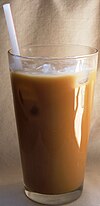This is an old revision of this page, as edited by AnomieBOT (talk | contribs) at 03:13, 18 May 2014 (Dating maintenance tags: {{Notability}}). The present address (URL) is a permanent link to this revision, which may differ significantly from the current revision.
Revision as of 03:13, 18 May 2014 by AnomieBOT (talk | contribs) (Dating maintenance tags: {{Notability}})(diff) ← Previous revision | Latest revision (diff) | Newer revision → (diff)| The topic of this article may not meet Misplaced Pages's general notability guideline. Please help to demonstrate the notability of the topic by citing reliable secondary sources that are independent of the topic and provide significant coverage of it beyond a mere trivial mention. If notability cannot be shown, the article is likely to be merged, redirected, or deleted. Find sources: "Ghetto latte" – news · newspapers · books · scholar · JSTOR (May 2014) (Learn how and when to remove this message) |

A ghetto latte,"bootleg latte","Poor Man's Latte", "Working Class Latte", and less pejoratively referred to as an "Iced Doppio with milk" or "Doppio espresso over ice with milk," is an iced espresso filled up with milk from the condiment station as opposed to being filled with milk by the barista. After a customer orders and pays for one or more shots of espresso poured over ice, the customer fills the cup with milk, cream, or half-and half, making a drink that is substantially similar to an iced latte or iced breve. This process can save the customer money, but would yield less revenue for the coffee shop owner as compared to those customers who pay for the barista to add the milk. The iced espresso is ordered in a larger to-go cup, the traditional espresso cup being too small.
The drink has spawned debate between customers and baristas - particularly those who work at Starbucks. Many people, wishing to save money (an iced espresso costs an average of $2.00 and a 16-ounce iced-latte costs an average of $4.00) have taken to this approach. As compared with a hot latte drink, which is made up of espresso shots, steamed milk, and a layer of foam, the iced drink is only espresso, ice, and chilled milk. So, customers can easily replicate the more expensive drink by adding chilled milk that is typically already available to customers who purchase beverages from the condiment bar in most coffee shops. Those seeking to stir controversy over this practice have raised questions about what the "ethical" usage of condiments is—in this case, how much milk is allowed to go into coffee beverages. Starbucks' official position is that "We provide condiments to our customers so they can make their drinks to their liking... We trust our customers to make the choices that are right for them."
Randall C. Picker, a law professor, noted that "Starbucks may be engaging in what an economist would call latte price discrimination. That means selling the same thing--the latte--to different customers for different prices. If we assume that the fake latte is profitable for Starbucks even when sold for $1.75, Starbucks may be perfectly willing to allow some of its customers to home-brew using Starbucks ingredients." Many baristas who work at smaller coffee shops that support local roasteries and brew single-origin coffees consider the ghetto latte to be unfair and inconsiderate others argue that the resulting beverage is inferior by claiming that "When you pour over ice, it creates a certain acidic reaction that makes the drink sour." If this is, in fact true, it would provide a natural disincentive to customers pouring milk into an iced doppio, and, thereby negate any ethical arguments raised against the practice. If the drink is actually indistinguishable to customers who choose to add their own milk, it would underscore the point made by Professor Picker.
See also
References
- Charles Leroux. 2006. The bootleg latte: Would you make one? October 5. Chicago Tribune.
- Ohrt, Andreas (22 November 2006). "SEND THE SAVINGS TO THE POOR DEHYDRATED CHILDREN OF THE WORLD WHO DON'T LIVE WITHIN A HALF A BLOCK OF A COFFEE SHOP". Boise Weekly. Retrieved 26 January 2010.
- Allison, Melissa (12 September 2006). "Baristas Having a Cow Over Dairy 'Thefts'". The Seattle Times. Retrieved 16 June 2010.
- Glaister, Dan (18 September 2006). "Ghetto-lattes have baristas in a froth". The Guardian. Retrieved 2009-06-29.
- McKinnell, Julie (30 October 2006). "A latte people stick it to Starbucks". Macleans.ca. Retrieved 2009-06-29.
- Picker, Randall C. (8 October 2006). "Latte serves up a lesson in bootleg economics". Chicago Tribune. Retrieved 26 January 2010.
- Popoken, Joe (15 July 2008). "Coffee-Shop Threatens To "Punch" Customer In His "Dick"". The Consumerist. Retrieved 26 January 2010.
- Heim, Joe (17 July 2008). "Espresso, Extra Bitter. Man's Tiff With Barista Spills Onto Internet". Washington Post. Retrieved 26 January 2010.